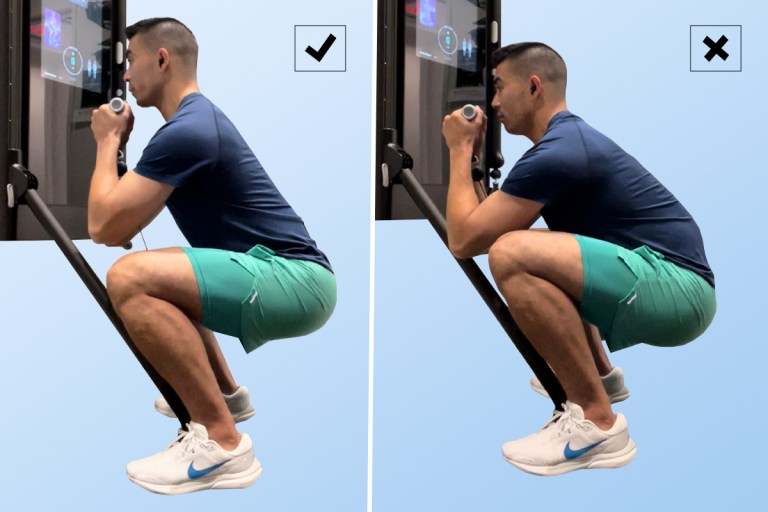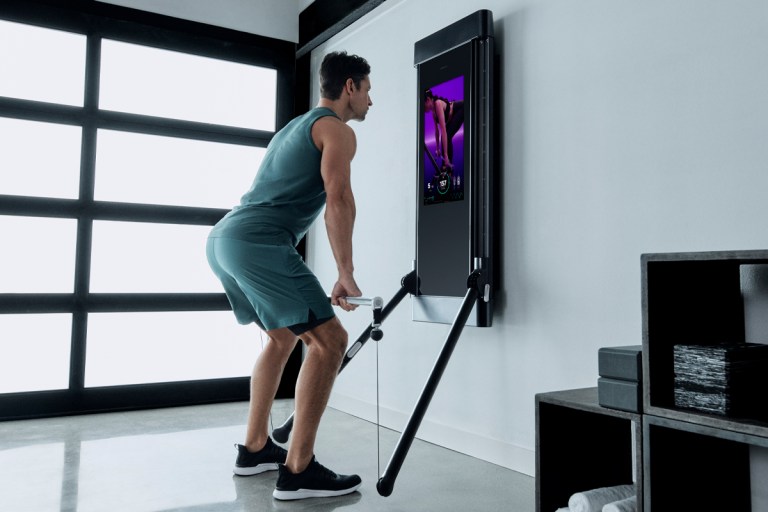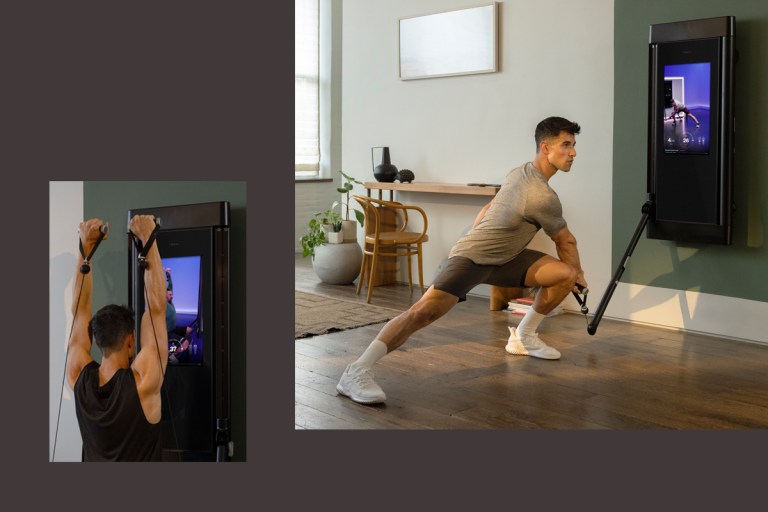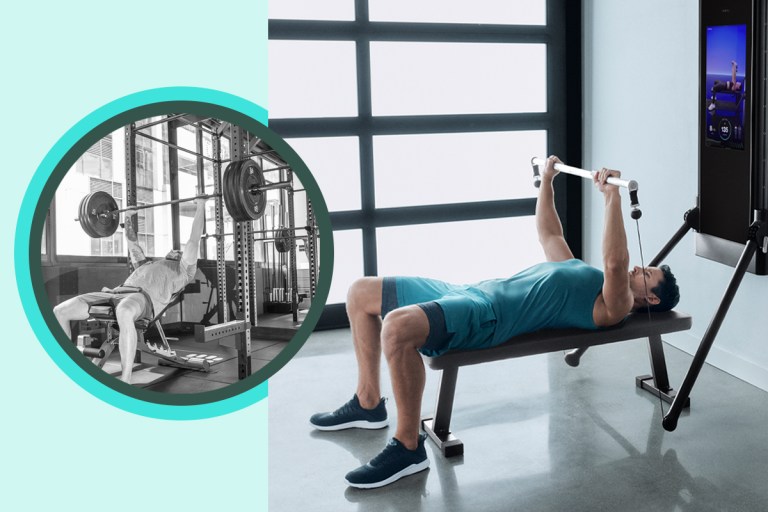Follow This Squat Progression to Unlock Massive Gains
The squat is a functional compound movement that’s essential to building all-around fitness. Here’s how to get started and make progress.

No matter your fitness goals, if you’re following a well-designed exercise program, you’ll likely find that squats are a regular part of your routine—and that’s no accident. The squat is an incredibly effective compound movement that engages your entire body but only when performed with proper form. That can be tough if you’ve never done one before. A squat progression, in which you move from easier to more difficult variations, will set you up for success.
“Most people are going to benefit from having the meat and potatoes of their program be compound movements,” says Tim Landicho, a certified personal trainer and Tonal coach. In these lifts, multiple joints and muscle groups work together at the same time, allowing you to build muscle more efficiently. Compound moves, including squats, deadlifts, and bench presses, are also more metabolically demanding than isolation moves, such as biceps curls or calf raises, meaning they elevate your heart rate and burn fat.
According to Landicho, the squat is a unique compound move as it strengthens your quads and glutes, and works your ankle, knee, and hip joint mobility, all while challenging you to maintain a strong core and upright torso.
Following the squat progression below will safely and effectively introduce your body to the movement.
First, Find Your Form
To get the most out of your squats, it’s important to learn the proper form before proceeding to more advanced variations. Here’s Landicho’s form checklist, which applies to most bilateral (two-legged) squat variations, whether you’re lifting a heavy bar or just your body weight.
Starting Position
- Stand with feet hip-width apart and toes pointed forward or out at an angle no more than 30 degrees. Try standing with your feet wider if that’s more comfortable.
- Keep your weight distributed evenly through your feet from heels to toes.
- Unlock your knees, standing with a soft bend.
- Keep your pelvis upright. Think of it as a bowl you’re trying not to spill forward.
- Engage your core by pulling your ribs toward your hip points.
- Keep your head stacked over your body and draw your shoulders back and down.
Squat Movement
- Send your hips back and bend your knees, tracking over your toes, while keeping your feet pressed into the floor, as if you’re sitting into a chair behind you.
- Your knees should track over the second or third toe, not collapse inward toward the big toe.
- Lower your hips as deeply as you can while keeping the ribcage stacked over your pelvis as you did at the start.
- Push through your feet to stand up tall and return to the starting position.
How Fast Should You Progress Your Squat?
Form and movement quality are key in progressing your squat, whether you’re adding resistance or moving on to a more challenging variation. Pay attention to how confident you feel going through the squatting motion and if you’re able to keep your form and full range of motion the whole way through.
On Tonal, features such as Form Feedback and Smart View will keep an eye on your form and offer corrections as needed. If you’re able to consistently maintain good form in a movement—and you’re getting fewer form feedback cues—you’re likely ready to add weight or progress to the next variation.
There’s also no rush in progressing in squat variations or weight. Studies show a minimum of 10 sets per week for each muscle group is ideal for gaining muscle, but that doesn’t mean you need to do 10 sets of squats every week. A well-rounded routine will include other moves for your legs and glutes, including lunges and deadlifts, which will also contribute to your squatting strength.
What’s the Best Way to Increase Your Squat?
Limited mobility and motor control may hinder your form and slow down your progress. You can improve motor control by simply practicing your squat form with bodyweight variations or doing core moves, such as the dead bug or pillar bridge, that will help you to stay upright in your squat.
“Play with these to bring sensory awareness to proper engagement throughout the day or immediately before the workout or squat progression,” says Landicho.
Mobility issues that limit squat form tend to come from the hips or ankles. Test your hip and ankle mobility and practice some drills that will build up your range of motion.
If you’re still struggling to lift heavier, try adding unilateral (single-leg) squat variations (detailed below). “People who mainly only do bilateral squats would really benefit from throwing in some unilateral training,” says Landicho. He explains that single-sided moves will reduce asymmetries between your two legs, ultimately making you stronger when you go back to a bilateral variation.
Squat Progression: From Beginner to Advanced
As you work through the squat progression below, keep the form checklist in mind. Start at the beginning if you’ve never squatted before, or jump in where you feel confident.
Beginner Squat Progression
If you’re squatting for the first time, start with these exercises to lock in the movement pattern you’ll use in all your squats.
Assisted Squat
Why it Works: Using Tonal or a wall for assistance, this movement will help you get used to the feeling of keeping your torso upright as you lower yourself down. Landicho says he’ll often use this bodyweight move as a warm-up before more complex squat variations.
How to Do it: With arms straight, grip each side of Tonal. Reach your hips back like you’re sitting into a chair behind you. Press the floor away from you and squeeze the glutes to stand tall.
Bodyweight Squat
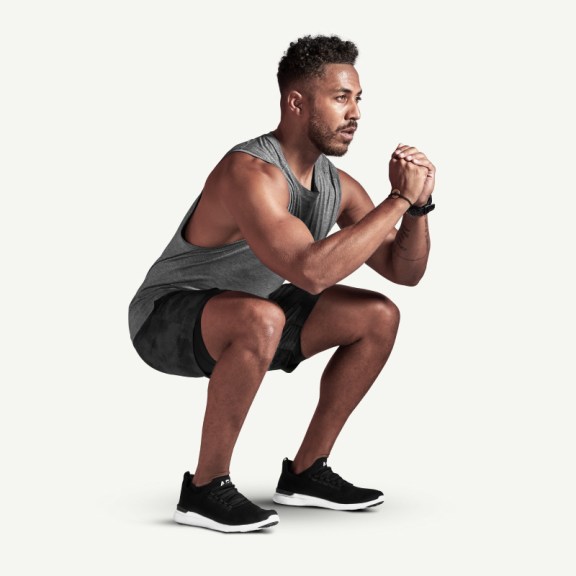
Why it Works: Practice your squat form before adding weight with a basic bodyweight squat. Learning to keep your core engaged and your chest upright will help when you start squatting with resistance.
How to Do it: Keeping your chest open to Tonal, reach your hips back like you’re sitting into a chair. Press the floor away from you and squeeze your glutes to power the hips forward toward Tonal and stand tall.
Goblet Squat to Bench
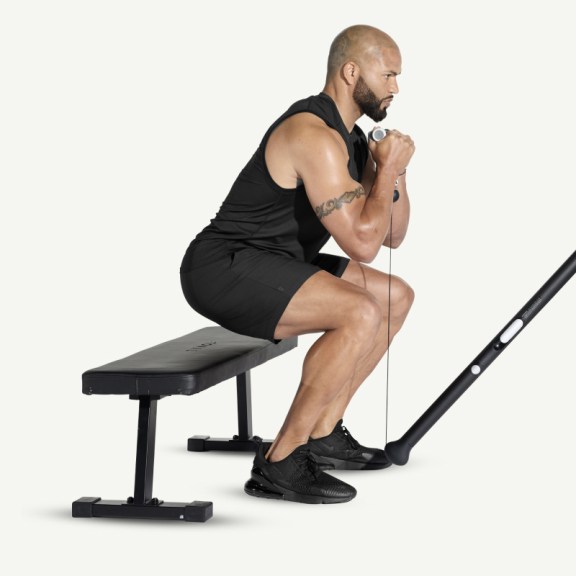
Why it Works: When you’re ready to add resistance, Landicho recommends this variation, in which you’ll use the bench to find the lowest point in your squat. Focus on just tapping your glutes on the bench—not fully sitting down—and then quickly standing back up.
“The bench gives you a little bit of feedback [to see] if you’re getting consistent depth each time,” he says. “Having that quick touchpoint really helps drill that pattern into your head until you can do it without the bench.”
How to Do it: Hold the handle strap with your thumbs wrapped around the top and place it in front of your chest. Stand over the end of Tonal’s arm with feet hip-width apart. Reach your hips back and bend your knees, as if someone is pulling you from behind, to tap your glutes on the bench. Stand by squeezing your glutes and pushing the floor away from you.
Bodyweight Split Squat
Why it Works: As you learn how to squat, you’ll want to include unilateral variations in your training as well. These single-sided moves improve balance, coordination, and stability.
“In the split squat, where your feet are staying in place the whole time and you’re just moving up and down, that’s going to provide you the most stability,” he says, explaining why this exercise is a great introduction to unilateral squats.
How to Do it: Lower your back knee to the mat creating 90-degree angles with both knees. Keeping your front heel down like it’s glued to the floor, push the floor away from you to power yourself up, and repeat on the same side.
Intermediate Squat Progression
Once the moves above feel like second nature, try these variations. See if you’re able to maintain the same form and muscle engagement when you remove the assistance of holding on to Tonal or using the bench as a guide.
Goblet Squat
Why it Works: After mastering the goblet squat to bench, this movement should feel familiar. Try to reach the same depth as before while keeping your upper body upright. “When the weight is in front, it forces you to engage your core a lot more,” says Landicho.
How to Do it: Hold the handle strap with your thumbs wrapped around the top and position it in front of your chest. Stand with feet shoulder-width apart and toes slightly turned out. Reach your hips down and back like you’re sitting into a chair behind you. Push the floor away from you and stand tall powering the hips toward Tonal and repeat.
Racked Squat

Why it Works: Similar to the goblet squat, this position keeps the weight in front of your body to help with core activation. It’ll prepare you for adding in the barbell as you progress.
How to Do it: Facing Tonal, take a handle in each hand and bring them to your shoulders with palms facing each other. Stand with feet hip-width apart at the end of Tonal’s arms. Reach your hips back as your knees bend like you’re sitting back into a chair. Stand by squeezing your glutes and pushing the floor away from you.
Goblet Split Squat
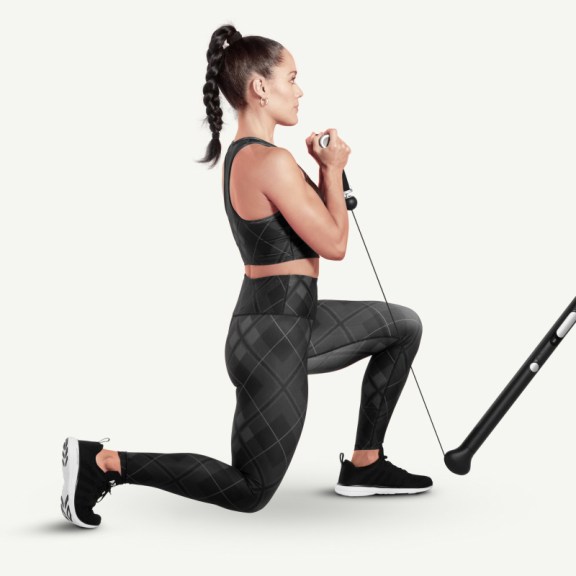
Why it Works: Keep up your unilateral training with this single-leg version of the goblet squat. You’ll maintain the same base of stability as in the bodyweight split squat but with added resistance for more of a challenge.
How to Do it: Hold the handle at the strap with thumbs wrapped around the top, place it in front of the chest, and position yourself in a split stance over your mat, feet about hip-width apart. Drop your back knee to the mat, creating 90-degree angles with the knees. Press your front heel down like it’s glued to the floor and power up. Bend the knees to drop down to the mat, allowing the back knee to graze the floor, and repeat on the same side.
Advanced Squat Progression
While the beginner and intermediate squat variations are very effective at strengthening your glutes and legs, to break through plateaus and keep the gains coming, you’ll want to take your squats to the next level with these more challenging moves.
Barbell Front Squat
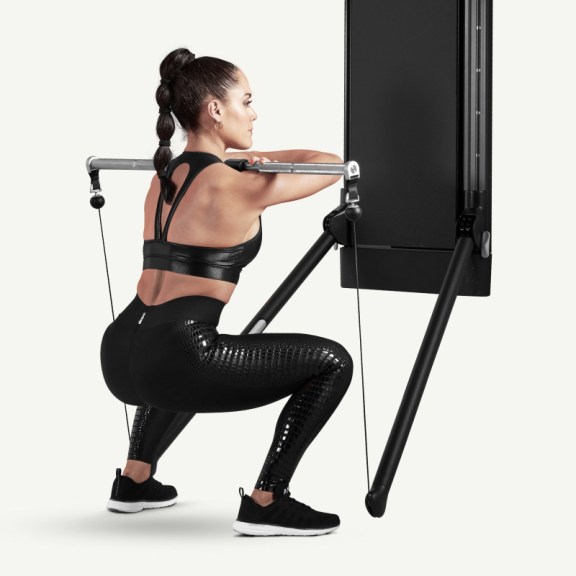
Why it Works: The barbell front squat may take some time to feel comfortable, but when you pin down the technique, you’ll be able to drive major strength and hypertrophy gains. “If you’re going to be pushing your strength and going for very heavy weight, then having one implement is going to provide you with more stability than two handles,” says Landicho.
This move does have more of a learning curve as you find the correct positioning of the barbell on your shoulders. Landicho recommends first practicing balancing the bar without any weight and your arms extended. Once you’re able to keep the bar in position through the squat movement, add your hands for support and start loading the weight.
How to Do it: Place the barbell on top of the shoulders until it is just barely touching the front of the neck. Cross your arms and lift the elbows to keep the bar in place. Stand with feet shoulder-width apart, toes slightly turned out. Reach the hips back and down like you’re into a chair behind you. Press the floor away from you by squeezing your glutes, powering your hips toward Tonal, and standing tall.
Barbell Back Squat
Why it Works: “A back squat will also allow someone to lift more overall weight [than a front squat] due to a more stable placement,” says Landicho. While this positioning may be more comfortable than the front squat, Landicho explains that keeping your core engaged is more challenging in a back squat.
How to Do it: Load the barbell in a squat rack and stand facing away. Place the barbell across your back, gripping it with your hands wider than shoulder-width. Stand with your feet shoulder-width apart, toes slightly turned out. Reach your hips back and down like you’re into a chair behind you. Press the floor away from you by squeezing your glutes, powering your hips forward as you stand tall.
Bulgarian Split Squat
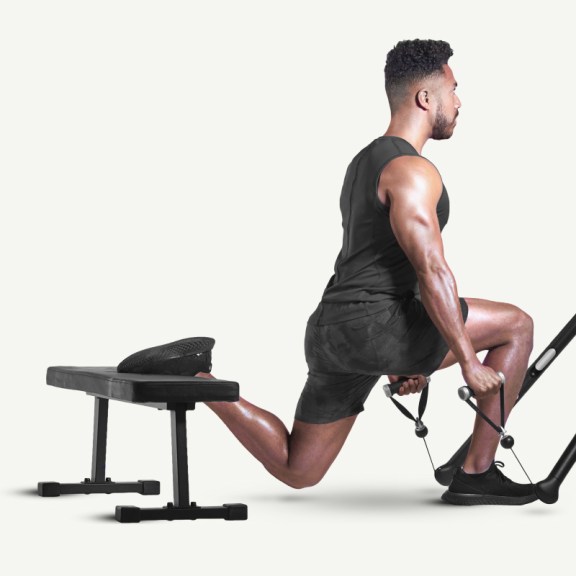
Why it Works: One of the more difficult single-leg squat variations, the Bulgarian split squat requires both strength and balance. With your rear foot elevated, you’re shrinking your base of stability from two feet to one.
How to Do it: Place one foot between Tonal’s arms and reach your opposite leg back, placing the top of the foot on the bench. Hold the handles and stand tall. Keeping your front heel down like it’s glued to the floor, bend both knees to drop your hips down until your front thigh is parallel with the floor. Press the floor away from you to stand and repeat on the same side.
